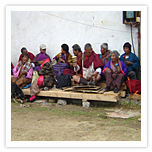Tours to Bhutan, Travel to Bhutan
- Bhutan Visitor Info
- Western Region Bhutan -
- Central Region Bhutan -
- Eastern Region Bhutan -
- Festivals of Bhutan -
- National symbols -
- History of Bhutan -
- Culture of Bhutan -
- Religion of Bhutan -
- People of Bhutan -
- Bhutan Visa & Customs -
- Bhutan Accommodation -
- Bhutan Transportation -
- Climate of Bhutan -
- Currency of Bhutan -
- Paro Festival Bhutan -
- Trekking in Bhutan -
People of Bhutan
For further Details Contact Us
 Bhutan
has long been a mysterious and elusive country for the Western world. It is
small and under populated when compared with its giant neighbours, China and
India. Despite its size, the country is an interesting mosaic of various
ethnicities without having an indigenous group. It is a nation of immigrants
and a multi-religious, multi-cultural and multi-linguistic society.
Bhutan
has long been a mysterious and elusive country for the Western world. It is
small and under populated when compared with its giant neighbours, China and
India. Despite its size, the country is an interesting mosaic of various
ethnicities without having an indigenous group. It is a nation of immigrants
and a multi-religious, multi-cultural and multi-linguistic society. From the yak herders of the north to the orange growers of the south, Bhutan boasts a fascinating kaleidoscope of people within a small area. Most of the population is from Mongoloid stock and speak languages of the Tibeto-Burman family. However, there are also people of Indo-Aryan stock in the south who speak languages of the Indo-Aryan family.
The people of Bhutan are called "Drukpas," a term which comes from Druk Yul, the name of the country in Dzongkha, the national language. The origin of the name Druk yul itself has an interesting story: it is said that in the twelfth century in Tibet, a monk called Tsangpa Gyare Yeshe Dorje wanted to build a monastery. When he was at the chosen spot, he heard thunder, which is believed to be the roar of a dragon. Taking this to be a good omen, he decided to call his monastery Druk, which means "thunder" or "dragon." As was prevalent in Tibet, the name of the religious school he founded took the name of the founding monastery and his followers were called "Drukpas." Much later, in the 17th century, the Drukpa religious leader, Shabdrung Ngawang Namgyel unified Bhutan. It then became Druk yul and the name Drukpas was given to all its inhabitants.
There are three main ethnic groups: the dominant political group the Ngalops; in the west, the Sharchops in the east and the southern Bhutanese of Nepali origin (also known as Lhotshampas) in the south. Largely Brokpas and Bjops inhabit northern regions of Bhutan. They are predominant in the regions of Merek and Sakten and in the northern regions of Bumthang, Lunganak, Gasa, Lingshi, Paro and Haa. Lhotshampas are of Nepali origin and live in the south, primarily in the districts of Chukha, Dagana and Samdrup Jonkhar districts. There are other smaller ethnic groups like the Santhals, Rajbansis, and Doyas. In addition there is a sizable modern Tibetan refugee population.

The Ngalop (a term thought to mean the earliest risen or first converted) are people of Tibetan origin who migrated to Bhutan as early as the 9th century. For this reason, they are often referred to in foreign literature as Bhote (people of Bhotia or Tibet). The Ngalop are concentrated in western and northern districts, which include Wangdi, Punakha, Dagana, Thimphu, Chukha, Paro, Haa and Gasa. They introduced Tibetan culture and Buddhism to Bhutan and comprise the dominant political and cultural element in modern Bhutan. Ngalop are often called Drukpas and are the ruling group who control the monarchy and the government and dominate the economy. The king and all the high government officials belong to this politically and economically dominant ethnic group. They live in the northwestern region, speak the Dzonkha language and wear robe-like dresses. They migrated from Tibet.
The Sharchop (the word means easterner), an Indo-Mongoloid people who are thought to have migrated from Assam or possibly Burma during the past millennium, comprise most of the population of eastern Bhutan and dominate the eastern areas namely Mongar, Tashigang, Bumthang, Mangde, Kheng, Kurtoe, Dungsum and Yangtse. Although long the biggest ethnic group in Bhutan, the Sharchop have been largely assimilated into the Tibetan-Ngalops culture. Because of their proximity to India, some speak Assamese or Hindi. They practice slash-and-burn and tsheri agriculture, planting dry rice crops for three or four years until the soil is exhausted and then moving on. They practice the Nyingmapa sect of Mahayana Buddhism and belong to Tibeto-Burman ancestry. They speak Tsangla, Kurteop, Kheng and Brokpa dialects and have supposedly migrated from North-east India.






